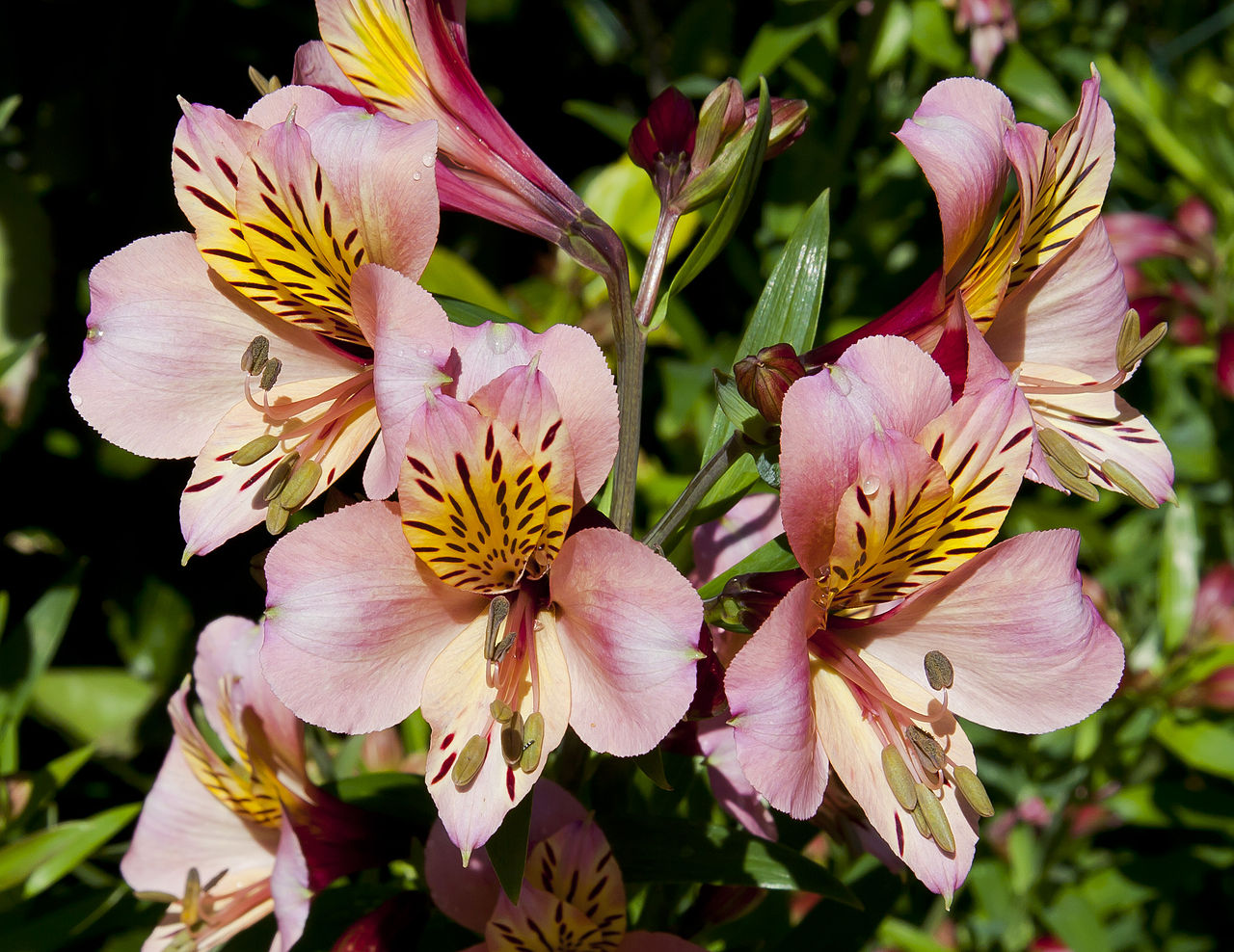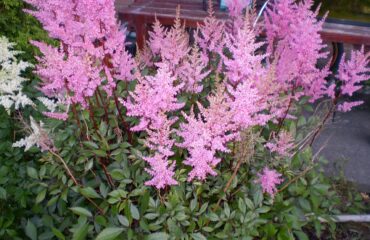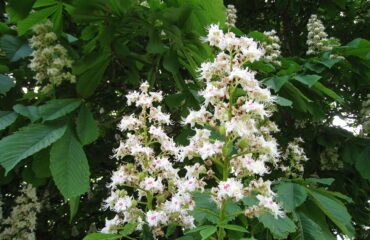Alstroemeria aurea, commonly known as the Peruvian Lily or Lily of the Incas, is a perennial plant native to South America. It is cherished for its striking, funnel-shaped flowers which come in vibrant hues of orange, yellow, pink, red, and even bi-colors, often adorned with intricate streaks and spots. The flowers are borne on long, sturdy stems that make them ideal for cut flower arrangements. The plant features lush, green, lance-shaped leaves that are often twisted, giving them a unique look.
Preferred Growing Conditions:
- Soil Type: Prefers well-drained, fertile, loamy soil, but can adapt to sandy or clay soils if well-drained.
- Sunlight: Thrives in full sun to partial shade. In hotter climates, provide some afternoon shade to protect from intense heat.
- Temperature: Hardy in USDA zones 7-10; prefers cooler to moderate temperatures and may need winter protection in colder zones.
- Water Needs: Regular watering is essential, keeping the soil consistently moist but not waterlogged.
Alstroemeria Aurea (Peruvian Lily) Propagation Methods:
1. Seed Propagation:
Seed propagation of Alstroemeria aurea is a method often chosen for breeding purposes or when specific cultivars are not required. While growing from seeds can be rewarding, it requires patience as the plants take a few years to mature and bloom.
- Seed Collection and Preparation:
- Collect seeds from mature seed pods once they turn brown and begin to split.
- Carefully harvest the seeds before they are dispersed by the pod’s explosive mechanism.
- Clean the seeds by removing any surrounding debris and allow them to dry for a few days.
- Seeds require stratification to improve germination rates. Place the seeds in a moist medium (like vermiculite or sand) and store them in a refrigerator at 40°F (4°C) for 4-6 weeks to mimic natural winter conditions.
- Sowing Techniques:
- After stratification, sow seeds in a seed-starting mix or a well-draining potting soil.
- Plant seeds about 1/4 inch deep and lightly cover with soil.
- Place the containers in a warm, bright location with temperatures around 70°F (21°C).
- Keep the soil consistently moist but not saturated.
- Germination can be slow and variable, often taking 4-8 weeks. Be patient and maintain optimal conditions.
- Care for Seedlings:
- Once seedlings emerge, provide them with bright, indirect light.
- Water regularly to keep the soil moist.
- When seedlings have developed several true leaves and are sturdy enough to handle, transplant them into individual pots.
- Gradually acclimate seedlings to outdoor conditions over a few weeks before planting them in the garden.
2. Division:
Division is the most effective and common method for propagating Alstroemeria aurea. This method not only helps propagate new plants but also rejuvenates the parent clump, promoting better growth and flowering.
- Timing:
- The best time for division is in early spring before new growth starts, or in autumn after flowering has finished.
- Method:
- Carefully dig up the entire plant clump, taking care not to damage the delicate tuberous roots.
- Gently shake off excess soil to expose the root system.
- Using a sharp knife or garden spade, divide the clump into smaller sections, ensuring each division has a few healthy shoots and a good portion of roots.
- Remove any damaged or dead roots and foliage.
- Replanting:
- Replant the divisions immediately into well-prepared soil enriched with compost or organic matter.
- Plant at the same depth as the original clump, spacing divisions 12-18 inches apart to allow room for growth.
- Water thoroughly to settle the soil around the roots.
- Care After Division:
- Keep the newly divided plants well-watered as they establish.
- Mulch around the base to retain soil moisture and regulate temperature.
- Protect from strong winds and harsh sunlight during the initial recovery period.
3. Rhizome Cuttings:
Propagating Alstroemeria aurea from rhizome cuttings can be an efficient way to produce new plants, especially when the plant is healthy and vigorous.
- Preparation:
- Select healthy rhizomes with visible growth buds.
- Using a clean, sharp knife, cut the rhizomes into sections, ensuring each piece has at least one or two buds.
- Allow the cut surfaces to dry and callous over for a few hours before planting. This helps prevent rot.
- Planting:
- Plant the rhizome sections horizontally in pots or directly in the garden, with the buds facing upward, just below the soil surface.
- Water lightly to settle the soil but avoid overwatering which can cause rot.
- Rooting and Growth:
- Rhizomes typically take several weeks to establish roots and shoots.
- Maintain consistent moisture and provide bright, indirect light until new growth is evident.
4. Tissue Culture:
Tissue culture is a more advanced method used primarily in commercial propagation to produce large numbers of plants from a small amount of tissue. While not commonly done by home gardeners, understanding the process can be useful.
- Process:
- Small pieces of plant tissue (often from the growing tips or meristematic tissue) are sterilized and placed in a nutrient-rich, sterile medium under controlled conditions.
- The tissue forms a callus, which eventually differentiates into shoots and roots.
- Once the plantlets are large enough, they are transferred to soil or a suitable growing medium to acclimate to normal growing conditions.
- Advantages:
- Produces a large number of uniform plants quickly.
- Can propagate disease-free plants and rare or difficult-to-propagate varieties.
5. Bulbil Propagation:
While less common, bulbils (small bulbs produced at the base of the stem) can also be used to propagate Alstroemeria aurea.
- Collection and Preparation:
- Collect bulbils from the base of the plant during the dormant season.
- Clean and dry bulbils before planting.
- Planting:
- Plant bulbils in small pots or directly in the garden, covering them with about 1/2 inch of soil.
- Keep the soil moist and provide bright, indirect light.
- Growth:
- Bulbils will develop roots and shoots over time and can be treated similarly to seedlings.
Care for Newly Propagated Plants:
- Transplant seedlings or divisions into a location that matches their growing conditions.
- Water regularly to establish strong root systems.
- Protect from extreme weather conditions and provide shade as needed.
- Fertilize with a balanced, slow-release fertilizer to encourage robust growth.
Common Challenges and Solutions:
- Root Rot: Ensure good drainage and avoid waterlogging.
- Pests: Monitor for aphids, slugs, and spider mites; treat with appropriate measures like insecticidal soap or organic pest controls.
- Poor Flowering: Ensure plants receive adequate sunlight and are not over-fertilized with nitrogen-heavy fertilizers, which promote leaf growth over flowering.
Additional Tips:
- Mulch around the base of the plants to retain moisture and suppress weeds.
- Deadhead spent flowers to encourage continuous blooming and prevent seed formation.
- Divide clumps every 2-3 years to maintain plant health and vigor.
Propagating Alstroemeria aurea can be a rewarding process that results in a stunning display of colorful blooms in your garden. Whether you choose to grow from seeds, divide mature plants, or use other propagation methods, with proper care and attention, these plants will thrive and bring beauty to your landscape for many seasons.
Share this article



